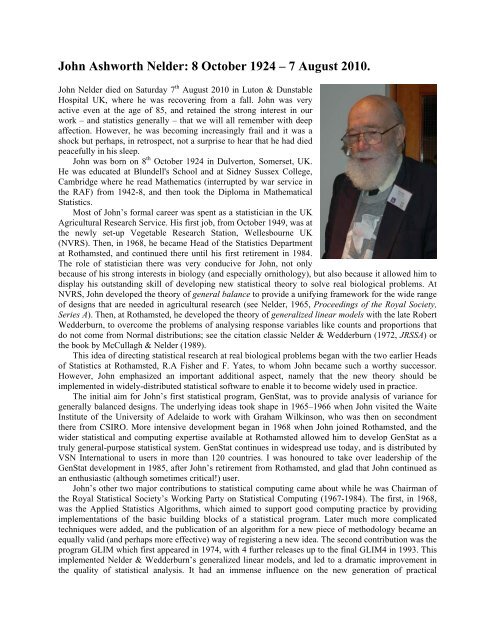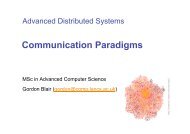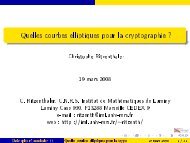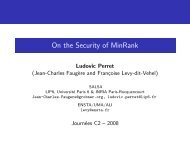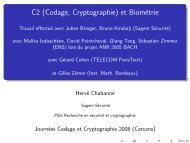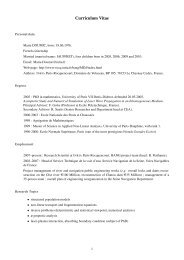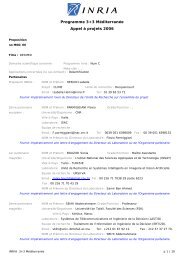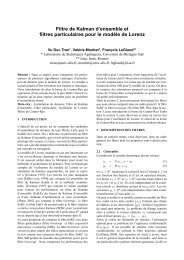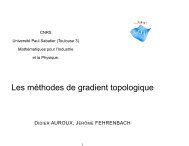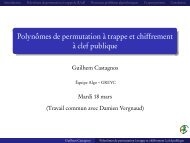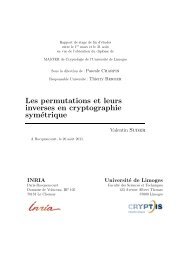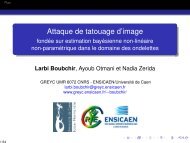John Ashworth Nelder FRS (8 October 1924 – 7 August 2010) was a ...
John Ashworth Nelder FRS (8 October 1924 – 7 August 2010) was a ...
John Ashworth Nelder FRS (8 October 1924 – 7 August 2010) was a ...
Create successful ePaper yourself
Turn your PDF publications into a flip-book with our unique Google optimized e-Paper software.
<strong>John</strong> <strong>Ashworth</strong> <strong>Nelder</strong>: 8 <strong>October</strong> <strong>1924</strong> <strong>–</strong> 7 <strong>August</strong> <strong>2010</strong>.<br />
<strong>John</strong> <strong>Nelder</strong> died on Saturday 7 th <strong>August</strong> <strong>2010</strong> in Luton & Dunstable<br />
Hospital UK, where he <strong>was</strong> recovering from a fall. <strong>John</strong> <strong>was</strong> very<br />
active even at the age of 85, and retained the strong interest in our<br />
work <strong>–</strong> and statistics generally <strong>–</strong> that we will all remember with deep<br />
affection. However, he <strong>was</strong> becoming increasingly frail and it <strong>was</strong> a<br />
shock but perhaps, in retrospect, not a surprise to hear that he had died<br />
peacefully in his sleep.<br />
<strong>John</strong> <strong>was</strong> born on 8 th <strong>October</strong> <strong>1924</strong> in Dulverton, Somerset, UK.<br />
He <strong>was</strong> educated at Blundell's School and at Sidney Sussex College,<br />
Cambridge where he read Mathematics (interrupted by war service in<br />
the RAF) from 1942-8, and then took the Diploma in Mathematical<br />
Statistics.<br />
Most of <strong>John</strong>’s formal career <strong>was</strong> spent as a statistician in the UK<br />
Agricultural Research Service. His first job, from <strong>October</strong> 1949, <strong>was</strong> at<br />
the newly set-up Vegetable Research Station, Wellesbourne UK<br />
(NVRS). Then, in 1968, he became Head of the Statistics Department<br />
at Rothamsted, and continued there until his first retirement in 1984.<br />
The role of statistician there <strong>was</strong> very conducive for <strong>John</strong>, not only<br />
because of his strong interests in biology (and especially ornithology), but also because it allowed him to<br />
display his outstanding skill of developing new statistical theory to solve real biological problems. At<br />
NVRS, <strong>John</strong> developed the theory of general balance to provide a unifying framework for the wide range<br />
of designs that are needed in agricultural research (see <strong>Nelder</strong>, 1965, Proceedings of the Royal Society,<br />
Series A). Then, at Rothamsted, he developed the theory of generalized linear models with the late Robert<br />
Wedderburn, to overcome the problems of analysing response variables like counts and proportions that<br />
do not come from Normal distributions; see the citation classic <strong>Nelder</strong> & Wedderburn (1972, JRSSA) or<br />
the book by McCullagh & <strong>Nelder</strong> (1989).<br />
This idea of directing statistical research at real biological problems began with the two earlier Heads<br />
of Statistics at Rothamsted, R.A Fisher and F. Yates, to whom <strong>John</strong> became such a worthy successor.<br />
However, <strong>John</strong> emphasized an important additional aspect, namely that the new theory should be<br />
implemented in widely-distributed statistical software to enable it to become widely used in practice.<br />
The initial aim for <strong>John</strong>’s first statistical program, GenStat, <strong>was</strong> to provide analysis of variance for<br />
generally balanced designs. The underlying ideas took shape in 1965<strong>–</strong>1966 when <strong>John</strong> visited the Waite<br />
Institute of the University of Adelaide to work with Graham Wilkinson, who <strong>was</strong> then on secondment<br />
there from CSIRO. More intensive development began in 1968 when <strong>John</strong> joined Rothamsted, and the<br />
wider statistical and computing expertise available at Rothamsted allowed him to develop GenStat as a<br />
truly general-purpose statistical system. GenStat continues in widespread use today, and is distributed by<br />
VSN International to users in more than 120 countries. I <strong>was</strong> honoured to take over leadership of the<br />
GenStat development in 1985, after <strong>John</strong>’s retirement from Rothamsted, and glad that <strong>John</strong> continued as<br />
an enthusiastic (although sometimes critical!) user.<br />
<strong>John</strong>’s other two major contributions to statistical computing came about while he <strong>was</strong> Chairman of<br />
the Royal Statistical Society’s Working Party on Statistical Computing (1967-1984). The first, in 1968,<br />
<strong>was</strong> the Applied Statistics Algorithms, which aimed to support good computing practice by providing<br />
implementations of the basic building blocks of a statistical program. Later much more complicated<br />
techniques were added, and the publication of an algorithm for a new piece of methodology became an<br />
equally valid (and perhaps more effective) way of registering a new idea. The second contribution <strong>was</strong> the<br />
program GLIM which first appeared in 1974, with 4 further releases up to the final GLIM4 in 1993. This<br />
implemented <strong>Nelder</strong> & Wedderburn’s generalized linear models, and led to a dramatic improvement in<br />
the quality of statistical analysis. It had an immense influence on the new generation of practical
statisticians. For many it provided their first experience of analysing data interactively, encouraging them<br />
to think about each data set, instead of directing it at a black box with a request for “statistics all”.<br />
<strong>John</strong> retired from Rothamsted in 1984 at the age of 60, but continued his research at Imperial College<br />
(of Science, Technology, & Medicine, London) where, since 1972, he had been a Visiting Professor. He<br />
retired from Imperial College in <strong>October</strong> 2009. His first task there <strong>was</strong> to lead the GLIMPSE project,<br />
which <strong>was</strong> funded by the UK Government’s Alvey programme to produce a knowledge-based front-end<br />
for GLIM. The GLIMPSE system provided advice on data validation, data exploration and model<br />
selection. It contained many very interesting and far-sighted ideas and, when it <strong>was</strong> released in 1989, it<br />
<strong>was</strong> one of the first statistical expert systems to be made available commercially <strong>–</strong> and perhaps one of the<br />
few to deliver what the originators had promised.<br />
<strong>John</strong>’s other major activity at Imperial College <strong>was</strong> his collaboration with Youngjo Lee to develop the<br />
theory of hierarchical generalized linear models (HGLMs); see the papers by Lee & <strong>Nelder</strong> (1996,<br />
JRSSB; 2001, Biometrika; 2006 Appl. Statist.) or the book by Lee, <strong>Nelder</strong> & Pawitan (2006). HGLMs<br />
aimed to provide satisfactory methods of analysis for non-Normal data when there is more than one<br />
source of random variation. <strong>John</strong> viewed generalized linear models as a way of liberating statisticians<br />
from the “tyranny” of the Normal distribution, and <strong>was</strong> a little bemused to see this same tyranny<br />
reestablished in methods that were devised initially to extend them. These generalized linear mixed<br />
models (GLMMs) catered for additional random variation by adding additional Normally-distributed<br />
random effects into the linear model of the generalized linear model. <strong>John</strong> and Youngjo’s new HGLMs<br />
extended the methodology to include the beta-binomial, gamma and inverse-gamma distributions, and<br />
showed that the conjugate HGLMs (namely binomial GLM with additional beta-binomial random effects,<br />
or Poisson with gamma, or gamma with inverse gamma) had attractive advantages in their mathematical<br />
theory, computing algorithms and philosophical interpretation. HGLMs can be fitted very efficiently by<br />
two interlinked generalized linear models. So we have access to a familiar repertoire of model checking<br />
techniques, and can base our choice of models on the data rather than on prejudice or software limitations.<br />
Also, the analysis can still be carried out interactively <strong>–</strong> always a very important consideration for <strong>John</strong>.<br />
With <strong>John</strong>’s many achievements in statistics, it is important not to forget his other interests. He shared<br />
a keen interest in gardening with his wife Mary (nee Hawkes), whom he met and married in 1955 while<br />
he <strong>was</strong> at NVRS; they have a son Jan and a daughter Rosalind. <strong>John</strong> and Mary were also keen<br />
birdwatchers, <strong>John</strong> combined ornithology with statistics by making a rigorous statistical assessment of the<br />
implausibility of the many rarities reported from Hastings during 1892-1930 (the “Hastings Rarities”);<br />
this provided convincing evidence for their subsequent rejection (see <strong>Nelder</strong>, 1962, British Birds). Finally<br />
he <strong>was</strong> a very keen musician and a virtuoso piano player, and his musical soirees at his house in Redbourn<br />
will be remembered by the attendees with lasting pleasure.<br />
<strong>John</strong> received many honours during his career. He had a DSc from University of Birmingham, and<br />
received an honorary DSc. from Universite Paul Sabatier, Toulouse, in 1981. He <strong>was</strong> also elected a<br />
Fellow of the Royal Society in 1981. He <strong>was</strong> President of the International Biometric Society from 1978-<br />
1979, and <strong>was</strong> made an Honorary Life Member in 2006. He <strong>was</strong> President of the Royal Statistical Society<br />
from 1985-1986, and <strong>was</strong> awarded Guy Medals of the Society in Silver in 1977, and in Gold in 2005. He<br />
wrote three books and over 120 papers in statistical and biological journals, including two citation<br />
classics: the <strong>Nelder</strong> & Wedderburn (1972, JRSSA) paper on generalized linear models already mentioned,<br />
and his paper written with Roger Mead while at NVRS describing their now very widely-used adaptive<br />
simplex optimization algorithm (see <strong>Nelder</strong> & Mead 1965, Computer Journal).<br />
More important perhaps is his statistical legacy of general balance, generalized linear models,<br />
hierarchical general linear models <strong>–</strong> and GenStat <strong>–</strong> which will keep him always in our thoughts.<br />
Roger Payne<br />
Rothamsted and VSN International<br />
An extended version of this Obituary, with the opportunity to add your own memories and messages of<br />
condolence, is at http://www.vsni.co.uk/featured/john-nelder/


